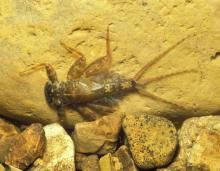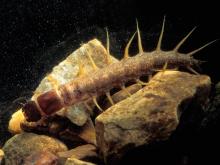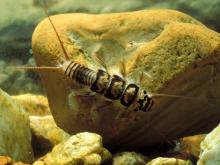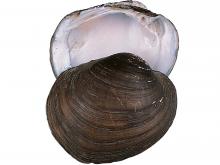Aquatic Invertebrates
Media

Species Types
Scientific Name
There are hundreds of species in North America.
Description
Mayfly larvae, or nymphs, live from months to years under water, breathing through gills, and the adults fly around in the air, mating, living for only a day or two.
Media

Species Types
Scientific Name
Chauliodes, Neohermes, and Nigronia spp. (in eastern US)
Description
Fishfly larvae look a lot like their cousins the hellgrammites, but they lack cottony or hairy gill tufts along the abdomen, and they have 2 short, fleshy tails at the hind tip.
Media

Species Types
Scientific Name
There are hundreds of species in North America
Description
Stonefly larvae are aquatic and somewhat resemble the larvae of mayflies and damselflies. Their presence usually indicates good water quality.
Media

Species Types
Scientific Name
Tabanus, Chrysops, and related genera
Description
The larvae of horse and deer flies are fairly straight, segmented, wormlike maggots that are tan, whitish, or brownish. They are aquatic or live in mud, and most are predaceous.
Media

Species Types
Scientific Name
Dugesia, Planaria, and other genera
Description
Unlike their parasitic cousins in the flatworm group, turbellarians, or planarians, are tiny carnivores or detritus-eaters that glide smoothly across submerged leaves and other objects.
Media

Species Types
Scientific Name
Venustaconcha ellipsiformis and V. pleasii
Description
These small mussels use darters, a type of fish, as hosts for their young.
Media

Species Types
Scientific Name
Epioblasma triquetra
Description
The snuffbox has been classified as endangered in Missouri and is a candidate for federal endangered status. Perhaps it should also be a candidate for a new common name, since the popularity of snuff-taking is long past.
Media

Species Types
Scientific Name
Lampsilis abrupta
Description
This endangered native mussel lives in flowing waters of large streams among gravel and cobble.
Media

Species Types
Scientific Name
Bivalve molluscs in order Unionoida
Description
Secretive and seldom seen, freshwater mussels are extraordinarily diverse in Missouri. We have nearly 70 species within our borders. Many are declining, and several are endangered.
Media

Species Types
Scientific Name
Over 20 Missouri species in former subclass Prosobranchia
Description
Gilled snails are one of two main groups of aquatic snails in Missouri (the other group is the "lunged" snails). Gilled snails, or prosobranchs, breathe with gills and possess a hard trapdoor-like operculum. They are most common in the Ozarks.
See Also
About Aquatic Invertebrates in Missouri
Missouri's streams, lakes, and other aquatic habitats hold thousands of kinds of invertebrates — worms, freshwater mussels, snails, crayfish, insects, and other animals without backbones. These creatures are vital links in the aquatic food chain, and their presence and numbers tell us a lot about water quality.





















